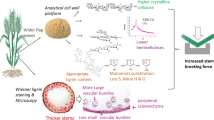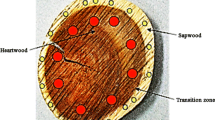Abstract
In carrying out a genetic analysis of rye in terms of a “brittle stem” trait, sister plants with normal and brittle stems were obtained. The culms of plants were studied in terms of chemical composition, spectroscopic parameters, and mechanical strength. Differences among plants with different types of culm were found in terms of a number of indicators, such as the content of aromatic monomers of lignin and the ratio of different types of chemical bonds. Culms of normal and brittle rye of the same diameter vary in terms of an elastic modulus and elastic deformation limit. It was found that stems of mutant plants are destroyed under lateral stress by means of the fragile fracture mechanism, while those in normal plants are destroyed by ductile fracture. The limits of elastic deformation and strength are significantly higher for normal plants. By nuclear magnetic resonance methods, we detected differences in the chemical structure of lignins in terms of the following: the content of aldehyde and methoxyl groups, total aromaticity, and the number of ordinary ether bonds, by which lignin units are associated with polysaccharide fragments of cellular walls. Higher lignin content in a mutant does not increase the mechanical strength of the culm. On the contrary, there is a decrease in the limits of elastic deformation and an increase in the fragility of the shoots. Probably, the mutation bs, except for direct action (brittleness of the culm), causes an imbalance of metabolic processes in the formation of secondary cell walls and leads to deviations from the optimal ratio of carbohydrate and lignin components. The differences found in various indicators can be used in breeding research associated with important economic traits of cereal stems.
Similar content being viewed by others
References
Ansari, M.J., Kumar, R., Singh, K., and Dhaliwal, H.S., Characterization and molecular mapping of EMS-induced brittle culm mutants of diploid wheat (Triticum monococcum L.), Euphytica, 2012, vol. 186, pp. 165–176.
Antropov, V.I. and Antropova, V.F., Rozh’ SSSR i sopredel’nykh stran (Rye of USSR and Adjacent Countries), Leningrad, 1929.
Bardinskaya, M.S., Rastitel’nye kletochnye stenki i ikh obrazovanie (Plant Cell Walls and Their Formation), Moscow: Nauka, 1964.
Burlat, V., Kwon, M., Davin, L.B., and Lewis, N.G., Dirigent proteins and dirigent sites in lignifying tissues, Phytochemistry, 2001, vol. 57, no. 6, pp. 883–897.
Burton, R.A., Ma, G., Baumann, U., et al., A customized gene expression microarray reveals that the brittle stem phenotype fs2 of barley is attributable to a retroelement in the HvCesA4 cellulose synthase gene1, Plant Physiol., 2010, vol. 153, pp. 1716–1728.
Chudakov, M.I., Investigation of the processes of condensation and oxidation-hydrolytic cleavage of hydrolytic lignin, Tr. VNIIGS, 1966, no. 15, pp. 285–290.
Dalimova, G.N. and Abduazimov, Kh.A., Lignins of herbaceous plants, Khim. Prir. Soedin., 1994, no. 2, pp. 160–177.
Davin, B.L. and Lewis, N.G., Dirigent proteins and dirigent sites explain the mystery of specificity of radical precursor coupling in lignan and lignin biosynthesis, Plant Physiol., 2000, vol. 123, no. 2, pp. 453–462.
Davison, F.R., Brewbacer, H.E., and Thompson, N.A., Brittle straw and other abnormalities in rye, J. Agric. Res., 1924, vol. 28, no. 2, pp. 169–172.
Doat, J. and Marie, R., Analyse d’un mutant a tige cassante radio-induit chez le riz, Oryza sativa L., Ann. Amelior. Plantes, 1977, vol. 27, pp. 705–715.
Gorshkova, T.A., Rastitel’naya kletochnaya stenka kak dinamichnaya sistema (The Plant Cell Wall as a Dynamic System), Moscow: Nauka, 2007.
Halpin, C., Knight, M.E., Foxon, G.A., et al., Manipulation of lignin quality by downregulation of cinnamyl alcohol dehydrogenase, Plant J., 1994, vol. 6, no. 3, pp. 339–350.
Kalabin, G.A., Kanitskaya, L.V., and Kushnarev, D.F., Kolichestvennaya spektroskopiya YaMR prirodnogo organicheskogo syr’ya i produktov ego pererabotki (Quantitative NMR Spectroscopy of Natural Organic Raw Material and Its Processing Products), Moscow: Khimiya, 2000.
Kokubo, A., Kuraishi, S., and Sakurai, N., Culm strength of barley: correlation among maximum bending stress, cell wall dimensions, and cellulose content, Plant Physiol., 1989, vol. 91, pp. 876–882.
Konovalov, A.A., Moiseeva, E.A., and Goncharov, N.P., Analysis of inheritance and linkage of certain characters in chromosome 5R of rye Secale cereale L., in Selektsiya 21 veka: noveishie tekhnologii, dostizheniya i perspektivy (Breeding in the 21st Century: the Latest Technology Advances and Prospects), Kharkov, 2008, pp. 106–112.
Konovalov, A.A., Moiseeva, E.A., Goncharov, N.P., and Kondratenko, E.Ya., The order of the bs, Skdh, and Aadh1 genes in chromosome 5R of rye Secale cereale L., Russ. J. Genet., 2010, vol. 46, no. 6, pp. 666–671.
Konovalov, A.A., Shundrina, I.K., Mamatyuk, V.I., and Goncharov, N.P., The study of the strength of the straw of rye Secale cereale L. by dynamic mechanical analysis, Dokl. RASKhN, 2013, no. 5 (in press).
Kul’turnaya flora SSSR (Cultivated Flora of the USSR), Vol. 2, Part 1: Rozh’ (Rye), Kobylyanskii, V.D., Ed., Leningrad: Agropromizdat, 1989.
Lignins. Occurrence, Formation, Structure and Reactions, Sarkanen, K.V. and Ludwig, C.H., Eds., New York: Wiley Interscience, 1971.
Monties, B., Mestres, C., and Baghdadi, K., Chemical and physical properties of a brittle culm lignin rich mutant of rice, Intern. Symp. on Wood and Pulping Chemistry, Stokholm, 1981, vol. 5, pp. 40–43.
Morrison, I.M., Changes in the lignin and hemicellulose concentrations of ten varieties of temperate grasses with increasing maturity, Grass Forage Sci., 1980, vol. 35, pp. 287–293.
Nagao, S. and Takahashi, M., Trial construction of twelve linkage groups in Japanese rice, in Genetical Studies on Rice Plant, J. Fac. Agr., Hokkaido Univ., Sapporo, 1963, vol. 53, pp. 72–130.
Obolenskaya, A.V., Shchegolev, V.P., Akim, G.L., et al., Prakticheskie raboty po khimii drevesiny i tsellyulozy (Practical Chemistry of Wood and Cellulose), Moscow: Lesn. Prom., 1965.
Rabinovich, M.L., Bolobova, A.V., and Kondrashchenko, V.I., Teoreticheskie osnovy biotekhnologii drevesnykh kompozitov (Theoretical Foundations of Biotechnology of Wood Composites), Book 1: Drevesina i razrushayushchie ee griby (Wood and Wood-Decaying Fungi), Moscow: Nauka, 2001.
Schlegel, R. and Melz, G., Genetic linkage map of rye (Secale cereale L.), in Genetic Maps, 6th ed., Cold Spring Harbor Lab. Press, 1993, pp. 6235–6255.
Sharma, U., Brillouet, J.-M., Scalbert, A., and Monties, B., Studies on a brittle stem mutant of rice, Oryza sativa L.; characterization of lignin fractions, associated phenolic acids and polysaccharides from rice stem, Agronomie, 1986, vol. 6, pp. 265–271.
Sharova, E.I., Kletochnaya stenka rastenii (The Cell Wall of Plants), St. Petersburg: Izd. St.-Peterb. Univ., 2004.
Sindhu, A., Langewisch, T., Olek, A., et al., Maize Brittle stalk2 encodes a COBRA-like protein expressed in early organ development but required for tissue flexibility at maturity, Plant Physiol., 2007, vol. 145, no. 4, pp. 1444–1459.
Smirnov, V.G. and Sosnikhina, S.P., Genetika rzhi (Rye Genetics), Leningrad: Izd. Leningr. Gos. Univ., 1984.
Surikov, I.M. and Romanova, N.P., The tight coupling of the vitriform straw gene with the self-incompatibility gene in rye, Byull. Vses. Nauchno-Issled. Inst. Rastenievod. im. N.I. Vavilova, 1982, no. 122, pp. 67–71.
Sybenga, J. and Prakken, R., Gene analysis in rye, Genetics, 1962, vol. 33, no. 2, pp. 95–105.
Wise, L.E. and Jan, E.S., Khimiya drevesiny (Wood Chemistry), Bogomolov, B.D., Ed., Moscow, 1959, vol. 1.
Vries, J.N. and Sybenga, J., Chromosomal location of 17 monogenically inherited morphological markers in rye (Secale cereale L.) using the translocation tester set, J. Plant Breed., 1984, vol. 92, no. 2, pp. 117–139.
Zaprometov, M.N., Fenol’nye soedineniya: rasprostranenie, metabolizm i funktsii v rasteniyakh (Phenolic Compounds: Distribution, Metabolism, and Function in Plants), Moscow: Nauka, 1993.
Author information
Authors and Affiliations
Corresponding author
Additional information
Original Russian Text © A.A. Konovalov, I.K. Shundrina, E.V. Karpova, V.I. Mamatyuk, 2013, published in Vavilovskii Zhurnal Genetiki i Selektsii, 2013, Vol. 17, No. 2, pp. 303–313.
Rights and permissions
About this article
Cite this article
Konovalov, A.A., Shundrina, I.K., Karpova, E.V. et al. Physicochemical properties of culms in rye (Secale cereale L.) with a brittle stem. Russ J Genet Appl Res 3, 455–463 (2013). https://doi.org/10.1134/S207905971306004X
Received:
Accepted:
Published:
Issue Date:
DOI: https://doi.org/10.1134/S207905971306004X




